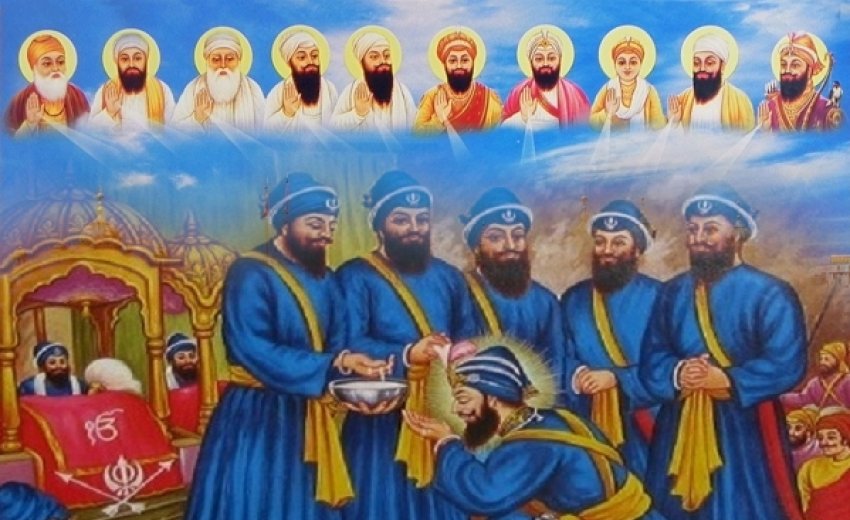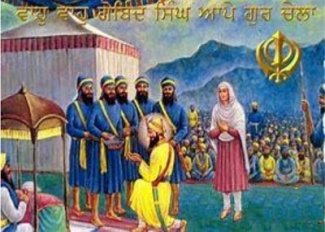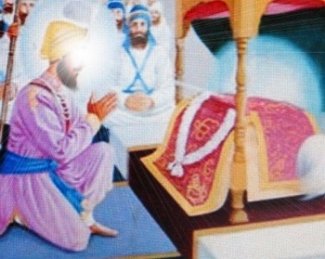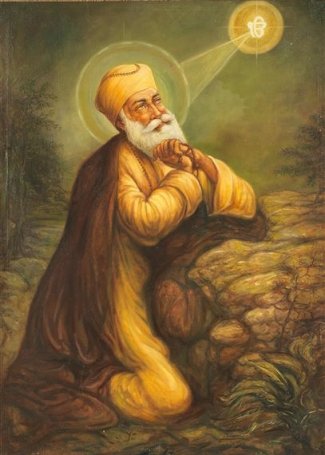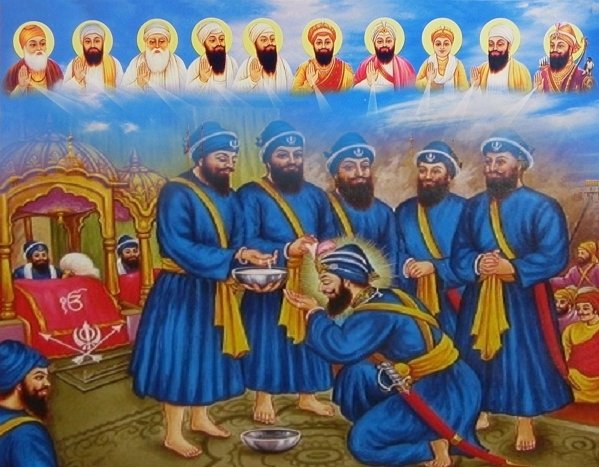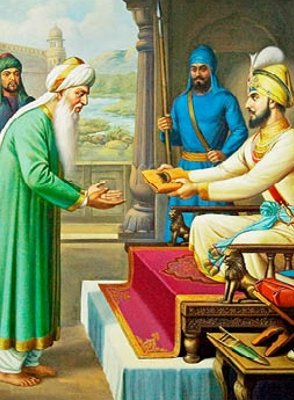When we celebrate Vaisakhi every year, we must also keep in mind What we are celebrating. I believe that on this day, Sikhs in America celebrate at least four aspects of our unique religion: (1) the actions taken by Guru Gobind Singh Ji on the Vaisakhi day of 1699; (2) the close connection between Guru Gobind Singh Ji’s actions and our previous Gurus’ teachings, as per the Guru Granth Sahib Ji; (3) the universality of Sikh teachings; and (4) the similarity of Sikh beliefs and American values.
(1) Guru Gobind Singh Ji’s Actions:
When Guru Gobind Singh Ji established the “Khalsa” on Vaisakhi day in March 1699:
-
He asked the Khalsa to live their lives as “Sant-Sipahis” (or Saint-Soldiers) –- i.e., as fully committed, disciplined disciples of the Guru, ready to give their all for their faith. This included defending the religious and human rights of Sikhs as well as others, and fighting against social and economic discrimination and political oppression in all its forms, wherever it exists.
-
The Guru considered the Khalsa as “Akal Purakh ki Fauj”, owing ultimate allegiance not to a human Guru but to the One God, i.e., to Akal Purakh or Vahiguru. Hence the Sikh greeting or Jaikara: “Vahiguru Ji Ka Khalsa, Vahiguru Ji Ki Fateh”.
-
Since that Vaisakhi day in 1699, all initiated Sikhs are expected to wear the 5 “Kakkars” -- kes, kangha, kara, kachehra, and kirpan -- so that they could be easily identified at all times.
-
Hence, on Vaisakhi Day we celebrate the joyous occasion of establishment of the Khalsa. This event proved to be a turning point in Sikh history. We are understandably proud of this remarkable history.
(2) The Teachings of the Guru Granth Sahib Ji:
These events of 1699 also remind us of the teachings of the Guru Granth Sahib Ji and the practices institutionalized by the Sikh Gurus. Four examples are given below:
First, Guru Gobind Singh Ji’s instruction to the Khalsa to live as a “Sant-Sipahi” ensured that the spiritual and secular aspects of a Sikh’s daily existence would be well integrated. He asked the Sikhs to sacrifice their life and livelihood for their faith, as had been instructed before by previous Gurus. The sixth Guru, Hargobind Sahib Ji and his Sikhs had fought many battles for just causes and protecting the Sikh faith, and the ninth Guru, Tegh Bahadur Sahib Ji had been martyred in defense of religious freedom for all.
Second, though the “Khalsa” Order was new, the distinct religious identity of the Sikhs had already been well established 200 years before the Vaisakhi of 1699. The distinctiveness of the Sikhs -- and of their religion -- originates not from the time of Guru Gobind Singh Ji, but from the time of Guru Nanak Sahib Ji. Sikhism’s distinctiveness is due not only to the Sikhs’ external appearance, but to the unique set of religious beliefs and teachings of Guru Nanak and his successor Gurus. It is the content of “Gurbani” – and the religious practices that emanate from it -- that distinguishes Sikhism from other religions, not just our personal attire.
Third, it was only this Gurbani -- i.e., the Bani of the first five Gurus and the Ninth Guru, and that of some selected Bhagats -- that Guru Gobind Singh Ji gave the “Gurgaddi” to, just before his demise in 1708. In instructing all Sikhs to consider this Granth as their Guru Eternal, Guru Gobind Singh Ji gave primacy to the Granth as Guru. He asked that Sikhs follow only the “Shabad” as Guru, just as Guru Nanak Sahib and his successor Gurus had instructed. The founder of Sikhism, Guru Nanak Sahib Ji, too considered the Revealed Word from Akal Purakh (“Dhur ki Bani”) as his only Guru.
And fourth, from the very beginning of Sikhism, Sikh practices were different from those of the surrounding Hindu and Muslim communities. When Guru Gobind Singh Ji created the Khalsa he asked that Sikhs follow the “outer” discipline of the “Bana” as well as “Bani”, the “inner” rehat maryada based on the Gurbani in the Guru Granth Sahib. Though Sikh practices have evolved over time, Sikhs have always been expected to follow both Gurbani and the religious practices introduced by the Gurus.
Hence, the Vaisakhi of 1699, or any other Vaisakhi day, should not be seen in isolation. The events of that day in 1699 not only created the Khalsa, but they also reinforced the teachings of the previous Gurus that provided its religious/doctrinal foundation. Guru Gobind Singh Ji was the Tenth Sikh Guru, not the First. The Vaisakhi events of 1699 built upon -- and were in accordance with -- the teachings of the Gurus that preceded him, and to the teachings of Guru Granth Sahib Ji to which he himself, in 1708, accorded the status of Guru Eternal.
Thus, our celebration of the Vaisakhi day of 1699 should simultaneously be a celebration of the Gurbani enshrined in the Guru Granth Sahib Ji. By remembering the religious/spiritual teachings underpinning the creation of the Khalsa in 1699, we celebrate the teachings of the “Shabad Guru”, rather than the teachings of any particular human Guru. We celebrate what it really means to be a Sikh. Not just on Vaisakhi day, but every day -- for the teachings of the Guru Granth Sahib Ji are timeless.
(3) The Universality of Sikh Teachings:
Guru Granth Sahib Ji’s message is relevant for everyone, everywhere. While the events of Vaisakhi day in 1699 have special significance for us Sikhs, the teachings of the Sri Guru Granth Sahib Ji are universal. They are meant for all of humanity, irrespective of time or place. Our Gurus were way ahead of their time, for example in terms of their emphasis on gender and racial equality. Emphasizing the “Oneness of God” and the “Oneness of humanity”, Sikhism makes no distinction on any basis -- be it caste, creed, nationality, religion, gender, or social or political status. We also expect our leaders to be transparent, democratic, and accountable to the people they seek to lead. Our Gurus, and their followers – i.e., all Sikhs -- are expected to wholeheartedly serve the common man and the common good, not just the elite of society, however defined.
(4) The Similarity of Sikh Beliefs and American Values:
These Sikh beliefs are important and relevant everywhere in the world, including America. They are similar to the values that Americans cherish and seek to live by. For Sikhs, there is no doubt that “In God We Trust.” Our Gurus’ emphasis on Liberty, Equality, and Fraternity predated the West’s call for these social values by about 300 years. Our Gurus’ teachings were fully consistent with, and came several centuries before, the words of the American Declaration of Independence which say that all men are created equal, and are endowed by their Creator with certain inalienable rights, including life, liberty, and the pursuit of happiness. And we certainly believe in, though we do not always practice, the truism that Women’s Rights are Human Rights.
Considering all this, there is much for us to celebrate, as we come together to joyously celebrate Vaisakhi this year, and every year. We celebrate all aspects of what truly makes us Sikhs!
